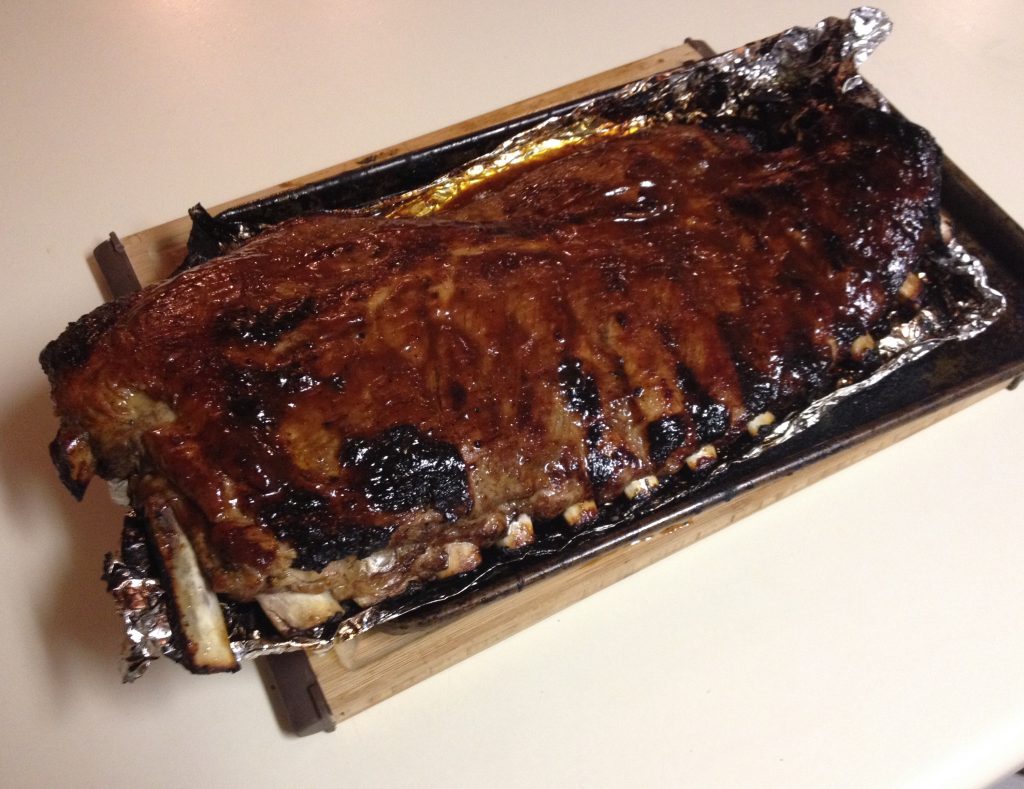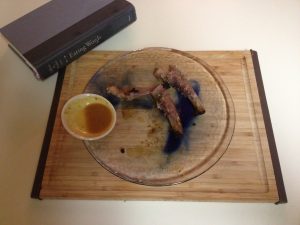Ah, the methods by which we prepare our food and the techniques with which we shovel that grub into our mouths – I have contemplated these aspects of eating at length and come to the conclusion they are two of the more important steps in feeding ourselves. And look how far we’ve come! It seems like just yesterday we were hacking away at critters with sharpened rocks. Next we were spearing chunks of flesh on sharpened sticks and sticking ‘em in that newfangled fire. Then along came utensils. What game changers!
Millennia have come and gone, and we like to think that we are more sophisticated now. If I attend a fancy dining engagement, there will be all sorts of funky knives surrounded by too many forks and spoons. Which one do I hack up the roasted critter with? I don’t know what the hell to do with all those knives, but I better make a decision ‘cause I’m hungry and I gotta eat.
Shoot, many Asian cultures stopped bringing all those preposterous pointy things to the dining room thousands of years ago. No, the culture took a different path to refinement, the bashi or kuaì-zì – what we call chopsticks. I’m no good with chopsticks, so what should I do? I better figure something out ‘cause I’m hungry and I gotta eat.
And why all this chopstick talk? Well, an excerpt on chopsticks from Margaret Visser’s The Rituals of Dinner got me thinking. Until now, I never pondered the why behind chopsticks.
Quite simply, chopsticks evolved from using just the index finger and thumb to pluck at foods. A pair of sticks used properly in their place refines the experience. The practice has become efficient yet elaborate, elegant in its unique etiquette. To this day, their skillful use is admired by all.
And your hands stay clean. An Asian chef’s skilled knife will render knives, forks, and napkins unnecessary at the table. This meal will be a job for chopsticks. As these rules of bashi became cemented across thousand-year dynasties in Japan and China, Visser says napkins became “not only redundant but downright nasty.” Visser also writes “Napkins laid on the knees are still an ‘ethnic’ Western affection in China and Japan.”
And here I am thinking I’m mannerly because I will pull a napkin out of the dispenser and put it on my lap. Sometimes.
The Far East really got a head start on refinement in the dining room compared to Western European culture. Fine blades, from the Samurai sword to the sharp Santoku, were all the rage in Japan – just not at the dinner table.
And why all the knife talk? Well an excerpt on knives from Bee Wilson’s Consider the Fork got me thinking, too. Back in the day, you wouldn’t be caught dead without your personal knife. Wilson explains how in medieval and Renaissance Europe “Your knife was as much a garment…as a tool.” Bashi was the standard in the East; meanwhile in Western Europe they were wandering around with claymores and daggers to each other’s throats.
Keep your dagger close by to hack up the mutton, and anybody who tries to interfere. Your weapon was a tool of sustenance, from the hunt to the butchery to the slicing of the roast at the beer hall table. An elegant knife was sophisticated – An elegant knife was expensive. Knives were all the rage back then, and to this day their skillful use is admired by all.
You know what? Knives and chopsticks are still a big deal. I go on about them with a tinge of jealousy in my heart – my chopsticks have rubber bands on the ends. A finger count is required of me before and after I chop an onion.
Let’s use the knife once. Let’s use the chopstick once. Let’s forget that nasty and redundant napkin for a while, too. Use your britches – they will still be, or at least they should be, on when you finish eating.
Let’s eat with our hands! Let’s make some ribs!

The Best Culinary Tools Yet!
The Easy Rib Cheat-Sheet
Everybody loves ribs. You can visit a tailgate party and don’t sweat it when you realize you left your dagger in the car. You can’t eat them with chopsticks really, unless your Bashi etiquette is so poor that you consider holding two rib bones in one hand is more or less like chopsticks. I fall in to this category.
We are going to cheat at this and keep it simple. No smoker, no grill. We will use only the oven. We will keep the ingredients simple. We will think more about the process than the fine details.
The Gist: Rub, Braise, Sauce, Broil… Eat!
The Meat: A full slab o’ pork ribs
I will be using whole pork spareribs for this one. They give you the most bang for your buck. If you catch them on sale (~$2.39/lb.) you can get this all done (minus equipment) for about twenty bucks.
You could go St. Louis cut (spareribs with the bottoms cut off) or Baby Back (above the spareribs) if you like. These cuts are more expensive.
The Equipment, to cook – You will need:
- A half-sheet pan or a pretty big cookie sheet
- A large shallow pan or baking dish, to drain the braising liquid
- Heavy Duty aluminum foil. The thicker stuff. The wide roll is best.
- Measuring cups and spoons
- A medium bowl
- A knife (The bigger and scarier, the better)
- A chopstick (The fancier and more ornate, the better)
The Rubdown, to season – You will need: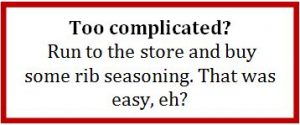
- 8 Tablespoons (½ cup) dark brown sugar, tightly packed
- 2 ½ tablespoons table salt, or 3 tablespoons kosher salt
- 1 tablespoon chili powder
- 1 tablespoon of whatever the hell kind of spices you want, maybe garlic and cayenne
The Meltdown, to braise – You will need: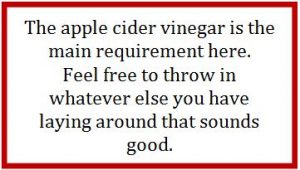
- ¾ cup apple cider vinegar
- ¼ cup apple juice or white wine
- ½ cup mustard
- 1 teaspoon Worcestershire sauce
- 3 tablespoons Liquid Smoke
- Pinch o’ salt
- Three cracks o’ pepper
- Two dashes of hot sauce
The Wipedown, to sauce – You will need:
- A bottle of your favorite barbecue sauce.
- Mixing in a couple tablespoons of Liquid Smoke will help out, too.
- Isn’t this easy?
Directions:
Preheat your oven to 225 degrees. This is easy to do, but it does take time. Cooking ribs is a lot like sloths at a limbo party – low and slow is the only way to do it. Low temp, slow cooking in a liquid is called braising.
Set aside a few hours to make this happen.
Let’s rub-a-dub.
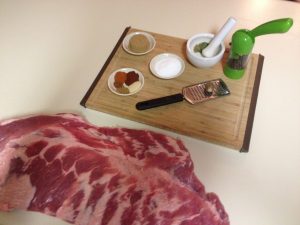
Mise en Place is French for “Get your shit together.”
Combine all the rub stuff in a bowl and mix it up. Use your hands!
Now let’s rub that stuff all over the meat. Knives and chopsticks will not be adequate for this job so again, use your hands.
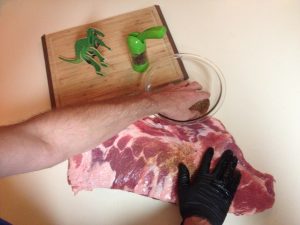
It’s fun to wear villainous black gloves.
Let’s make our braising liquid now.
Toss all that vinegar and whatnot in a saucepan and bring it to a simmer long enough to dissolve all that sugar and stuff. Stir it with your hand. Ok, Ok… use a spoon or whisk.
Then, we’re gonna make a big pouch for our ribs to braise in.

From this…

…to this.
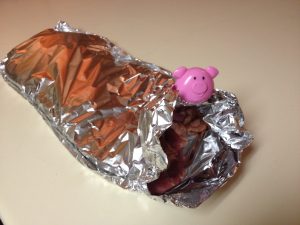
Oink.

Pour in that funky stuff.
Let’s cook.
Seal up the pouch and throw that pig chunk in the oven for 2 ½ hours.
After that time is up, check ‘em out and see what you think. The meat should be drawn back from the bones, and those bones should be kinda wiggly in the meat. Is it to your liking? If not, just braise some more and check back in 45 minutes or so.
Remove the ribs from the oven (not with your bare hands, use a potholder), and carefully drain the liquid.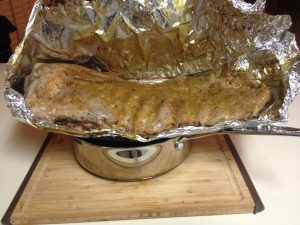
Use your chopstick to poke a hole in the foil.
Time to broil!
Go ahead and turn the broiler on high. Make sure the oven rack is centered. In all seriousness, be careful here. That thing will be damned hot.
Slather the ribs in barbecue sauce on both sides. Find a loofah or paintbrush or something to get the job done. A spoon will work in a pinch. Don’t use your bare bandaged hands for this. (You forgot the potholder, didn’t you?)
Line the sheet pan with fresh foil. Place the sauced ribs meat side-down on the pan and place under the broiler.
Give it about 5 minutes in the broiler, but keep a close eye on it – the sugar in the sauce will caramelize and brown quickly. It’s just a minute more to burning, once the browning happens.
Time to flip. Slather some more.
It will be another five minutes or so, maybe seven. Just keep an eye on it and you’ll know when. There will be smoke!
Cut these with your knife.




